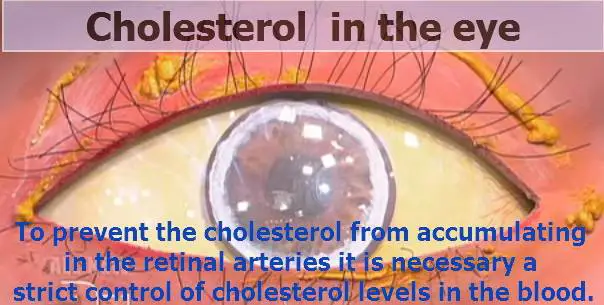
Can one have cholesterol in eyes for real?
In a person with normal cholesterol levels, the eyes do not have cholesterol. It is not a normal compound of the structures in which the eye is composed of.
However, there are certain pathological conditions in which we can find cholesterol in the eyes.
How is Cholesterol causing eye problems?
When the level of cholesterol in the bloodstream is very high, it starts to build up in the walls of arteries, forming thick plaques.
If the levels of cholesterol continue to stay high, more and more cholesterol will be deposited in these plaques.
These plaques can be formed in every part of the body that is passed by arteries. The retina of the eye has many tiny arteries.
The cholesterol plaques developed in the retinal arteries, narrow the interior space of these arteries causing so less blood flow in the retina.
In such circumstances, the retinal tissue suffers from a lack of oxygen and it does not function properly. The patient will then complain of blurred sight
Sometimes, when the plaque is thick enough to block the retinal central artery, and the blood flow is totally blocked, the patient has immediately painless vision loss.
The cholesterol in the eyes is presented in three forms:
1. The Corneal arcus ( arcus senilis) – It is a thin grey ring around the cornea and it is actually a deposit of fat and cholesterol in the eye.
This can be common in older people, but it is not considered common in young patients. If such a finding is made, cholesterol and triglyceride treatments are recommended.
2. Hollenhorst plaque – Small pieces of fatty material (cholesterol) that have broken off the walls of arteries and travel to the eyes.
This can lead to the occlusion of retinal blood vessels causing sudden loss of vision. This is a serious condition, indicating serious cholesterol problems and the patient must be sent for further examinations.
3. Xanthelasma – They are deposits of cholesterol under the skin. They are yellow, painless, and soft. Xanthelasmas do not interfere with vision and are often treated by dermatologists.
What can one do to reduce the risks of getting Cholesterol in the eyes?
Cholesterol accumulates in the eye arteries only if the levels of it in the bloodstream are high. To prevent the cholesterol from accumulating in the retinal arteries it is necessary strict control of cholesterol levels in the blood.
It is very important to take your medicaments as prescribed by the doctor, and some lifestyle changes.
The lifestyle changes include a healthy diet, without fatty foods, exercising several days a week, losing weight, and quitting smoking if you are a smoker.
